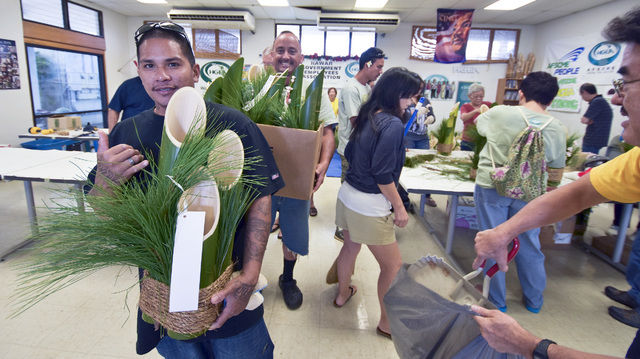Wayne Mukai of the HGEA said there are not that many kadomatsu this year because the bamboo is not of the best quality. On Saturday, their work of assembling was shortened because of the lack of bamboo. Tamara Akau (she’s
Wayne Mukai of the HGEA said there are not that many kadomatsu this year because the bamboo is not of the best quality. On Saturday, their work of assembling was shortened because of the lack of bamboo.
Tamara Akau (she’s president of the Hawaii club in college) is a recipient of the Charles Kendall Scholarship which benefits from the sale of the New Year’s decoration and was helping mom, Teresa Caires, put together the bamboo, pine and plum branch decoration.
Aiko Takayama, in a special article to the Hawaii Herald, said there are “kadomatsu rules” (who wanted to know this?) people should follow. Toshigami-sama is the name of the Shinto god who visits people through fresh matsu, or pine, and stays in Kadomatsu, temporarily.
Kadomatsu is to attract the god and give her a space to stay during the New Year, or oshogatsu, period, bringing happiness and prosperity.
Rule 1 is the preparation, shougatsu-kotohajime, which begins after Dec. 13, or matsumukae, or greeting the pine. Dec. 29 is a no-no because it is considered a bad luck day because of the number 9. Japanese culture says 9 means suffering, so 2-9 means double suffering, and finally, no kadomatsu on Dec. 31 because it shows a lack of respect to the gods.
Because we have a no-burn rule, kadomatsu is discarded (Patrick Watase said use salt, too) along with the trash after Jan. 7.
Call Joni at 245-6751 for your kadomatsu which helps the Kendall Scholarship.
•••
Dennis Fujimoto, staff writer and photographer, can be reached at 245-0453 or dfujimoto@thegardenisland.com.





